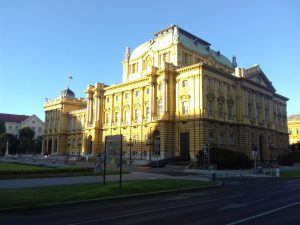
July 20, 2017, by lzzeb
Natures in Between: ESEH Biennial Conference, Zagreb 28 June to 2 July 2017
A blog by Dr Pietro Piana
The 9th Biennial Conference of the European Society for Environmental History took place at the University of Zagreb, Croatia, between 28 June – 2 July. Thanks to the financial support from the School of Geography’s Research Committee I attended the conference and contributed to a session. The title of the conference was ‘Natures in between, environments in areas of contact among states, economic systems, cultures and religions’. Zagreb and Croatia were an ideal location for such stimulating theme. The venue was at the University of Zagreb and at the National Archive with its incredible secessionist building designed in 1913 by architect Rudolph Lubynswi.
There were 110 sessions with participants from all over the world and European countries in particular. The themes were various, from climate change to migration, but one of the focuses of the conference was the Environmental History of Croatia. Before gaining independence in 1991, this nation went through the domination of several different foreign countries, Venice, the Ottomans, the Austro-Hungarian Empire and Italy, and for almost half a century it was part of Yugoslavia. Croatia’s interesting history is reflected in Zagreb’s urban landscapes, its fascinating architecture, city planning and place names.
Amongst my personal highlights of the conference was a session on the Environmental Histories of the Broader Adriatic. The session gathered contributions from Croatian, Slovenian and Italian universities. The papers documented how land use changes in borderland areas of the Balkans were shaped and conditioned by the economic and political context. The sessions provided evidence of a rich patrimony of written and iconographical sources produced under different dominations through the centuries. Other good sessions I attended were concerned with agricultural transformations in both old and recent times and their reflections on current rural management policies. Several sessions dealt with the study of past floods and extreme weather events through a multisource approach which involves the use of written sources, maps and oral histories.
My session was organized by Professor Charles Watkins and was titled ‘Evidence of Conflict and Appropriation of Woodland and Landscape Resources in Nineteenth Century Croatia and Italy’. A fascinating paper by Ivan Tekić (University of Nottingham) dealt with the environmental history of pine woodlands in North Dalmatia. Ivan documented how what is today one of the most characteristic trees of the Dalmatian coast is the result of several reforestations carried out since the nineteenth century, particularly under the Austrian domination. Pine woods in Dalmatia were considered a symbol of land acquisition; nineteenth-century agronomists and foresters encouraged this plantation arguing that the harsh and dry landscape of the Karst would have benefited from pine woods in terms of aesthetics, climate and economy. Another paper by Professor Diego Moreno, Dr Valentina Pescini (University of Genoa, Italy) and Professor Roberta Cevasco (University of Pollenzo, Italy) dealt with several examples of ‘conflicts’ between traditional and ‘institutional’ practices and in the management of mountain and coastal landscapes of the Ligurian Apennines. Our paper was titled ‘The ‘Appropriation’ by Wealthy Foreign Residents in the 19th Century of Traditional Western Ligurian Wooded Landscapes’. We presented some preliminary results of a study on the establishment of gardens and exotic species (palms particularly) in Liguria by foreign residents. This study is part of our Leverhulme project on topographical art and landscape in NW Italy (1835-1815). Through the use of iconographical sources (topographical drawings, historical photographs, maps) we documented how foreign visitors who settled in Liguria in the second half of the nineteenth century shaped the coastal landscape of the Riviera importing tropical species and establishing new gardens and plantations that are now a typical element of the Ligurian coast.
No comments yet, fill out a comment to be the first


Leave a Reply